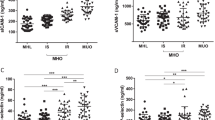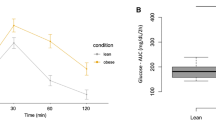Abstract
Background/objectives
Vascular adhesion protein-1 (VAP-1) can enhance tissue glucose uptake in cell studies and normalize hyperglycemia in animal studies. However, serum VAP-1 concentration (sVAP-1) is higher in subjects with diabetes in cross-sectional studies. In this cohort study, we test our hypothesis that sVAP-1 is increased in prediabetes to counteract hyperglycemia and is associated with incident diabetes negatively.
Subjects/methods
From 2006 to 2012, 600 subjects without diabetes from Taiwan Lifestyle Study were included and followed regularly. Diabetes was diagnosed if FPG ≥ 126 mg/dL (7 mmol/L), 2-h plasma glucose (2hPG) during an oral glucose tolerance test (OGTT) ≥ 200 mg/dL (11.1 mmol/L), or hemoglobin A1c (HbA1c) ≥ 6.5%, or if the subject received anti-diabetic medications. Abdominal fat areas were measured by abdominal computed tomography and sVAP-1 was analyzed by ELISA.
Results
sVAP-1 was higher in subjects with prediabetes (p < 0.05) and increased during an OGTT (p < 0.001). Fasting sVAP-1 was associated with the response of sVAP-1 during an OGTT (p < 0.001). Besides, sVAP-1 was associated negatively with body mass index (BMI, r = −0.1449, p = 0.003), waist circumference (r = −0.1425, p = 0.004), abdominal visceral (r = −0.1457, p = 0.003), and subcutaneous (r = −0.1025, p = 0.035) fat areas, and serum high-sensitivity C-reactive protein (hsCRP) concentration (r = −0.2035, p < 0.0001), and positively with plasma adiponectin concentration (r = 0.2086, p < 0.0001), adjusted for age and gender. After 4.7 ± 2.6 years, 73 subjects (12.2%) developed incident diabetes. High sVAP-1 predicted a lower incidence of diabetes, adjusted for age, gender, BMI, family history of diabetes, HbA1c, HOMA2-%B and HOMA2-IR (HR = 0.66, 95% CI = 0.50–0.88, p < 0.01).
Conclusions
sVAP-1 is increased in response to hyperglycemia. It is associated with obesity and serum hsCRP concentration negatively, and plasma adiponectin concentration positively. Besides, a high sVAP-1 is associated with a lower incidence of diabetes in human.
This is a preview of subscription content, access via your institution
Access options
Subscribe to this journal
Receive 12 print issues and online access
$259.00 per year
only $21.58 per issue
Buy this article
- Purchase on Springer Link
- Instant access to full article PDF
Prices may be subject to local taxes which are calculated during checkout



Similar content being viewed by others
References
Salmi M, Jalkanen S. VAP-1: an adhesin and an enzyme. Trends Immunol. 2001;22:211–6.
Salmi M, Jalkanen S. A 90-kilodalton endothelial cell molecule mediating lymphocyte binding in humans. Science (New Y, N Y). 1992;257:1407–9.
Pannecoeck R, Serruys D, Benmeridja L, Delanghe JR, Geel N, Speeckaert R, et al. Vascular adhesion protein-1: role in human pathology and application as a biomarker. Crit Rev Clin Lab Sci. 2015;52:284–300.
Yu PH, Wright S, Fan EH, Lun ZR, Gubisne-Harberle D. Physiological and pathological implications of semicarbazide-sensitive amine oxidase. Biochim Biophys Acta. 2003;1647:193–9.
Abella A, Marti L, Camps M, Claret M, Fernandez-Alvarez J, Gomis R, et al. Semicarbazide-sensitive amine oxidase/vascular adhesion protein-1 activity exerts an antidiabetic action in Goto-Kakizaki rats. Diabetes. 2003;52:1004–13.
Yu PH, Wang M, Fan H, Deng Y, Gubisne-Haberle D. Involvement of SSAO-mediated deamination in adipose glucose transport and weight gain in obese diabetic KKAy mice. Am J Physiol Endocrinol Metab. 2004;286:E634–41.
Gres S, Bour S, Valet P, Carpene C. Benzylamine antihyperglycemic effect is abolished by AOC3 gene invalidation in mice but not rescued by semicarbazide-sensitive amine oxidase expression under the control of aP2 promoter. J Physiol Biochem. 2012;68:651–62.
Carpene C, Daviaud D, Boucher J, Bour S, Visentin V, Gres S, et al. Short- and long-term insulin-like effects of monoamine oxidases and semicarbazide-sensitive amine oxidase substrates in cultured adipocytes. Metabolism. 2006;55:1397–405.
El Hadri K, Moldes M, Mercier N, Andreani M, Pairault J, Feve B. Semicarbazide-sensitive amine oxidase in vascular smooth muscle cells: differentiation-dependent expression and role in glucose uptake. Arterioscler Thromb Vasc Biol. 2002;22:89–94.
Karim S, Liaskou E, Fear J, Garg A, Reynolds G, Claridge L, et al. Dysregulated hepatic expression of glucose transporters in chronic disease: contribution of semicarbazide-sensitive amine oxidase to hepatic glucose uptake. Am J Physiol Gastrointest Liver Physiol. 2014;307:G1180–90.
Stolen CM, Yegutkin GG, Kurkijarvi R, Bono P, Alitalo K, Jalkanen S. Origins of serum semicarbazide-sensitive amine oxidase. Circ Res. 2004;95:50–7.
Li HY, Wei JN, Lin MS, Smith DJ, Vainio J, Lin CH, et al. Serum vascular adhesion protein-1 is increased in acute and chronic hyperglycemia. Clin Chim Acta. 2009;404:149–53.
Ma WY, Yang CY, Shih SR, Hsieh HJ, Hung CS, Chiu FC, et al. Measurement of waist circumference: midabdominal or iliac crest? Diabetes Care. 2013;36:1660–6.
Lin MS, Li HY, Wei JN, Lin CH, Smith DJ, Vainio J, et al. Serum vascular adhesion protein-1 is higher in subjects with early stages of chronic kidney disease. Clin Biochem. 2008;41:1362–7.
Hung CS, Lee JK, Yang CY, Hsieh HR, Ma WY, Lin MS, et al. Measurement of visceral fat: should we include retroperitoneal fat? PLoS ONE. 2014;9:e112355.
Li HY, Lin MS, Wei JN, Hung CS, Chiang FT, Lin CH, et al. Change of serum vascular adhesion protein-1 after glucose loading correlates to carotid intima-medial thickness in non-diabetic subjects. Clin Chim Acta. 2009;403:97–101.
Standards of medical care in diabetes-2017. Classification and diagnosis of diabetes. Diabetes Care. 2017;40(Supplement 1):S18–20.
Little RR, Rohlfing CL, Wiedmeyer H-M, Myers GL, Sacks DB, Goldstein DE. The national glycohemoglobin standardization program: a five-year progress report. Clin Chem. 2001;47:1985–92.
Boomsma F, Bhaggoe UM, van der Houwen AM, van den Meiracker AH. Plasma semicarbazide-sensitive amine oxidase in human (patho)physiology. Biochim Biophys Acta. 2003;1647:48–54.
Li HY, Jiang YD, Chang TJ, Wei JN, Lin MS, Lin CH, et al. Serum vascular adhesion protein-1 predicts 10-year cardiovascular and cancer mortality in individuals with type 2 diabetes. Diabetes. 2011;60:993–9.
Lyssenko V, Almgren P, Anevski D, Perfekt R, Lahti K, Nissen M, et al. Predictors of and longitudinal changes in insulin sensitivity and secretion preceding onset of type 2 diabetes. Diabetes. 2005;54:166–74.
Lorenzo C, Wagenknecht LE, Rewers MJ, Karter AJ, Bergman RN, Hanley AJ, et al. Disposition index, glucose effectiveness, and conversion to type 2 diabetes: the Insulin Resistance Atherosclerosis Study (IRAS). Diabetes Care. 2010;33:2098–103.
Schultz CH, Rivers EP, Feldkamp CS, Goad EG, Smithline HA, Martin GB, et al. A characterization of hypothalamic-pituitary-adrenal axis function during and after human cardiac arrest. Crit Care Med. 1993;21:1339–47.
Hekimian G, Baugnon T, Thuong M, Monchi M, Dabbane H, Jaby D, et al. Cortisol levels and adrenal reserve after successful cardiac arrest resuscitation. Shock (Augusta, Ga). 2004;22:116–9.
Stolen CM, Madanat R, Marti L, Kari S, Yegutkin GG, Sariola H, et al. Semicarbazide sensitive amine oxidase overexpression has dual consequences: insulin mimicry and diabetes-like complications. FASEB J. 2004;18:702–4.
Enrique-Tarancon G, Marti L, Morin N, Lizcano JM, Unzeta M, Sevilla L, et al. Role of semicarbazide-sensitive amine oxidase on glucose transport and GLUT4 recruitment to the cell surface in adipose cells. J Biol Chem. 1998;273:8025–32.
Morin N, Lizcano JM, Fontana E, Marti L, Smih F, Rouet P, et al. Semicarbazide-sensitive amine oxidase substrates stimulate glucose transport and inhibit lipolysis in human adipocytes. J Pharmacol Exp Ther. 2001;297:563–72.
Enrique-Tarancon G, Castan I, Morin N, Marti L, Abella A, Camps M, et al. Substrates of semicarbazide-sensitive amine oxidase co-operate with vanadate to stimulate tyrosine phosphorylation of insulin-receptor-substrate proteins, phosphoinositide 3-kinase activity and GLUT4 translocation in adipose cells. Biochem J. 2000;350(Pt 1):171–80.
Aalto K, Maksimow M, Juonala M, Viikari J, Jula A, Kahonen M, et al. Soluble vascular adhesion protein-1 correlates with cardiovascular risk factors and early atherosclerotic manifestations. Arterioscler Thromb Vasc Biol. 2012;32:523–32.
Meszaros Z, Szombathy T, Raimondi L, Karadi I, Romics L, Magyar K. Elevated serum semicarbazide-sensitive amine oxidase activity in non-insulin-dependent diabetes mellitus: correlation with body mass index and serum triglyceride. Metabolism. 1999;48:113–7.
Weiss HG, Klocker J, Labeck B, Nehoda H, Aigner F, Klingler A, et al. Plasma amine oxidase: a postulated cardiovascular risk factor in nondiabetic obese patients. Metabolism. 2003;52:688–92.
Gurecka R, Koborova I, Csongova M, Sebek J, Sebekova K. Correlation among soluble receptors for advanced glycation end-products, soluble vascular adhesion protein-1/semicarbazide-sensitive amine oxidase (sVAP-1) and cardiometabolic risk markers in apparently healthy adolescents: a cross-sectional study. Glycoconj J. 2016;33:599–606.
Koborova I, Gurecka R, Csongova M, Volkovova K, Szoko E, Tabi T, et al. Association between metabolically healthy central obesity in women and levels of soluble receptor for advanced glycation end products, soluble vascular adhesion protein-1, and the activity of semicarbazide-sensitive amine oxidase. Croat Med J. 2017;58:106–16.
Bour S, Caspar-Bauguil S, Iffiu-Soltesz Z, Nibbelink M, Cousin B, Miiluniemi M, et al. Semicarbazide-sensitive amine oxidase/vascular adhesion protein-1 deficiency reduces leukocyte infiltration into adipose tissue and favors fat deposition. Am J Pathol. 2009;174:1075–83.
Li HY, Lee WJ, Chen MJ, Chuang LM. Change in vascular adhesion protein-1 and metabolic phenotypes after vertical banded gastroplasty for morbid obesity. Obes Res. 2005;13:855–61.
Bour S, Daviaud D, Gres S, Lefort C, Prevot D, Zorzano A, et al. Adipogenesis-related increase of semicarbazide-sensitive amine oxidase and monoamine oxidase in human adipocytes. Biochimie. 2007;89:916–25.
Mercier N, Moldes M, El Hadri K, Feve B. Semicarbazide-sensitive amine oxidase activation promotes adipose conversion of 3T3-L1 cells. Biochem J. 2001;358(Pt 2):335–42.
Ziemke F, Mantzoros CS. Adiponectin in insulin resistance: lessons from translational research. Am J Clin Nutr. 2010;91:258S–61S.
Ruotsalainen E, Vauhkonen I, Salmenniemi U, Pihlajamaki J, Punnonen K, Kainulainen S, et al. Markers of endothelial dysfunction and low-grade inflammation are associated in the offspring of type 2 diabetic subjects. Atherosclerosis. 2008;197:271–7.
Salmi M, Kalimo K, Jalkanen S. Induction and function of vascular adhesion protein-1 at sites of inflammation. J Exp Med. 1993;178:2255–60.
Li HY, Lin HA, Nien FJ, Wu VC, Jiang YD, Chang TJ, et al. Serum vascular adhesion protein-1 predicts end-stage renal disease in patients with type 2 diabetes. PLoS One. 2016;11:e0147981.
Yu TY, Li HY, Jiang YD, Chang TJ, Wei JN, Lin CM, et al. Serum vascular adhesion protein-1 level predicts risk of incident cancers in subjects with type II diabetes. Cancer Epidemiol Biomark Prev. 2014;23:1366–73.
Acknowledgements
This work is supported in part by the grant from the National Science Council, Taiwan (NSC 101-2314-B-002-069-MY3). The authors would like to thank the staff of the eighth Core Lab, Department of Medical Research, National Taiwan University Hospital for their technical and computing assistance.
Author contributions
CH Kuo researched data, contributed to the discussion, and drafted the manuscript. JN Wei researched data, contributed to the discussion, wrote/reviewed the manuscript. CY Yang, HY Ou, HT Wu, KC Fan, SH Wang, CH Hsiao, MK Lee researched data, contributed to the discussion, and reviewed/edited the manuscript. CH Hua provided laboratory assistance and contributed to the discussion. HY Li researched data, contributed to the discussion, and wrote/reviewed/edited the manuscript. HY Li is the guarantor of this work and, as such, had full access to all the data in the study and takes responsibility for the integrity of the data and the accuracy of the data analysis.
Author information
Authors and Affiliations
Corresponding author
Ethics declarations
Conflict of interest
The authors declare that they have no conflict of interest.
Electronic supplementary material
Rights and permissions
About this article
Cite this article
Kuo, CH., Wei, JN., Yang, CY. et al. Serum vascular adhesion protein-1 is up-regulated in hyperglycemia and is associated with incident diabetes negatively. Int J Obes 43, 512–522 (2019). https://doi.org/10.1038/s41366-018-0172-4
Received:
Revised:
Accepted:
Published:
Issue Date:
DOI: https://doi.org/10.1038/s41366-018-0172-4
This article is cited by
-
Vascular adhesion protein-1 and microvascular diabetic complications
Pharmacological Reports (2022)
-
Obesity of mice lacking VAP-1/SSAO by Aoc3 gene deletion is reproduced in mice expressing a mutated vascular adhesion protein-1 (VAP-1) devoid of amine oxidase activity
Journal of Physiology and Biochemistry (2021)
-
Sick fat: the good and the bad of old and new circulating markers of adipose tissue inflammation
Journal of Endocrinological Investigation (2019)



